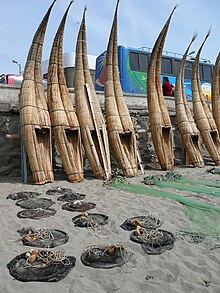
Reed boats and rafts, along with dugout canoes and other rafts, are among the oldest known types of boats. Often used as traditional fishing boats, they are still used in a few places around the world, though they have generally been replaced with planked boats. Reed boats can be distinguished from reed rafts, since reed boats are usually waterproofed with some form of tar.[1] As well as boats and rafts, small floating islands have also been constructed from reeds.
The earliest discovered remains from a reed boat are 7000 years old, found in Kuwait. Reed boats are depicted in early petroglyphs and were common in Ancient Egypt. A well-known example from the Book of Exodus is the ark of bulrushes in which the baby Moses was set afloat. They were also constructed from early times in Peru and Bolivia, and boats with remarkably similar design have been found in Easter Island and also New Zealand where they were made by indigenous Māori.[2] Reed boats are still used in Peru, Bolivia, Ethiopia, and until recently in Corfu. The explorations and investigations of the Norwegian ethnographer and adventurer Thor Heyerdahl have resulted in a better understanding of the construction and capabilities of reed boats.
- ^ McGrail S (1985) Towards a classification of Water transport World Archeology, 16 (3).
- ^ Barclay-Kerr, Hoturoa (12 June 2006). "Mōkihi". Te Ara: The Encyclopedia of New Zealand.